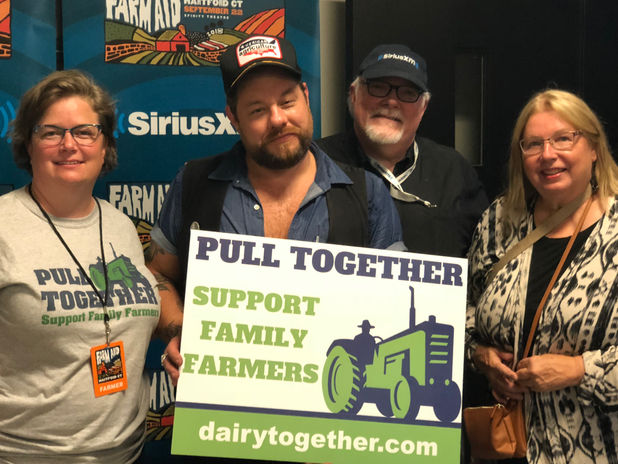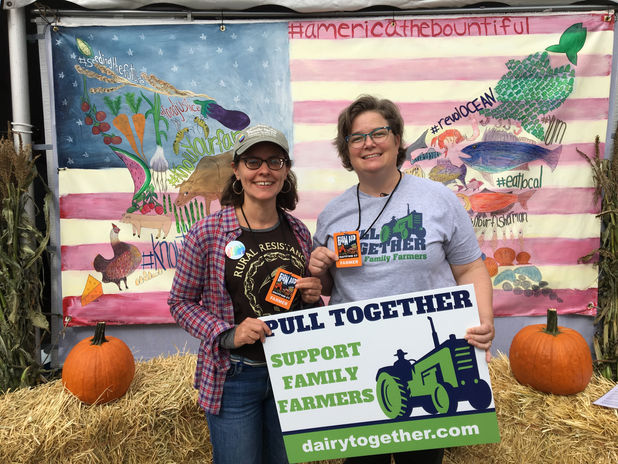

A vision for the future of dairy
The Dairy Revitalization Plan
Wisconsin Farmers Union calls on Congress to establish a mandatory program for managed growth, based on market demand and price stability. WFU supports the Dairy Revitalization Plan, based on the study, “Analyses of Proposed Alternative Growth Management Programs for the US Dairy Industry,” conducted by Charles Nicholson and Mark Stephenson and funded by the University of Wisconsin Baldwin Wisconsin Idea program, the Grassland 2.0 project, the Wisconsin Cover Crops Research and Outreach Program, and Center for Integrated Agricultural Systems (CIAS) of the University of Wisconsin.

Who we are
Dairy Together embraces a vision to preserve and grow a vibrant agricultural landscape in Wisconsin and across the country; one where many farms operate at different scales to ensure a stable supply of food, use a variety of conservation practices to create a healthy environment, and generate enough profit for farmers and workers to make a good living doing something they love. We envision a future where the rural communities supported by these farms are some of the most desirable places to live.

The dairy price crisis
In recent years, dairy news headlines have been dismal as a flood of milk on the market contributed to five years of depressed and volatile milk prices that eroded the quality of life for dairy farmers across the country. Over the last decade, the USDA recorded the loss of roughly 17,000 dairy farms, cutting the total number by nearly one third. Many of these farms have been driven out by government policies and industry practices that favor mass production of commodities over family farm viability.

Building a farmer-led movement
Dairy farmers have been struggling through boom and bust price cycles for decades. The word “crisis” has become so familiar in farm country that it hardly registers alarm anymore. Nevertheless, the collapse in milk prices in 2015, coupled with the failure of both government and industry to keep them afloat, spurred dairy farmers into action. It sparked an interest in looking at solutions that would allow them to actually make a living on their farms. In 2018, Wisconsin Farmers Union began connecting with dairy farmers and allies across the country to explore ways to reform dairy markets. It turned out, we weren’t the only ones. We met with a number of farmers and farm organizations that agreed we need to curb overproduction and level the playing field to enhance the viability of family farm agriculture. And so, Dairy Together was born.



Dairy Together hits the road
In 2019, Dairy Together held meetings from coast to coast to present a menu of policy options that would improve milk prices and keep family farms in business. We learned that the industry has done a really good job at convincing farmers that their value lies only in their productivity and that the only way to make money in dairy is to get bigger. We also learned that so many farmers were desperate for a different approach. While many expressed reservations about a Canadian-style quota system, farmers big and small, from California to Vermont, were interested in adopting a national program that keeps supply and demand in better balance.

Dairy at a crossroads
The U.S dairy industry is changing at a rapid pace. Over the last twenty years, the prevalence of very large dairies has transformed the structure of the dairy industry. These farms can continue to expand while others go out of business in droves. The only dairy farms that are growing in number are those with 2,000+ cows, while every other farm size category is in sharp decline. Federal dairy programs were not designed with these dynamics in mind. If we want to have diversity in farm size, location, production methods, and conservation practices - and realize our vision of a sustainable farm economy - we need to coordinate growth in milk production so that one farmers’ decision to expand doesn’t drive someone else out of business. If we do nothing, the writing is on the wall for the vast majority of the 30,000 dairy farms that remain, locking us into a very risky and uncertain future where just a handful of mega dairies supply all of our milk and dairy products.

Next stop: 2023 Farm Bill
Through the Dairy Together project, we have listened and learned from family farmers across the country and coalesced around an approach that is fair, effective, and politically feasible. With the Farm Bill set to expire in 2023, we have an opportunity to reform dairy markets in a way that creates better balance and long-term stability. The good news is, the American philosophy around food and farming is shifting and the dairy industry will have to adapt. The “get big or get out” mentality that brought forth a system of large-scale corporate agriculture has run its course. The farm policies of the future will favor fair prices, rural resilience, diversity, and public health. The next farm bill is our opportunity to turn the corner and embrace these values as we usher in a new era for agriculture. We know a whole lot of dairy farmers who can hardly wait.
Dairy Together calls on Congress to establish a mandatory program for managed growth based on market demand and price stability in the 2023 Farm Bill. Such a program should increase farmer profitability by:
1. Elevating milk prices
2. Preventing overproduction
3. Reducing milk price volatility
Such a program should also:
1. Allow for beginning farmer entry
2. Reduce government expenditures
3. Respond to global market conditions
4. Be national and mandatory so that all dairy producers participate
5. Allow for planned growth when the market can accept additional milk
6. Be designed in such a way that any production base does not acquire value
7. Have meaningful farmer input in development, implementation, and governance
%20copy%203.png)





